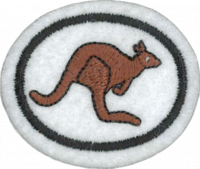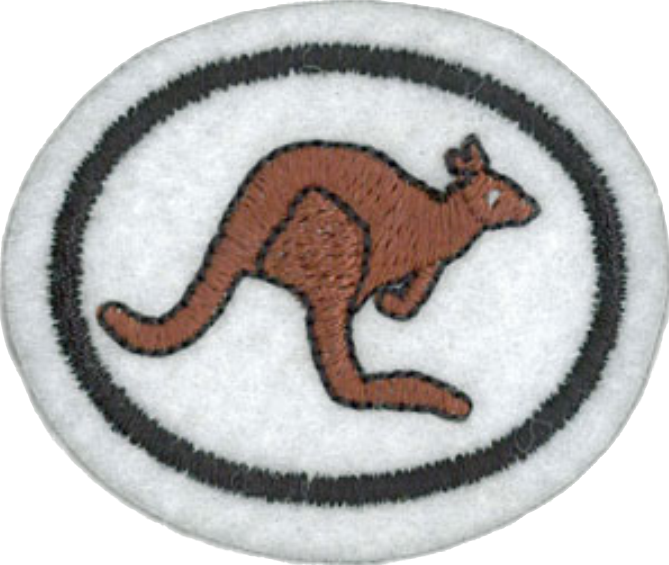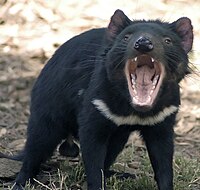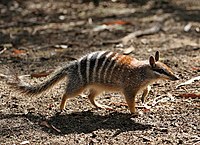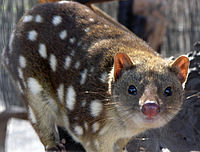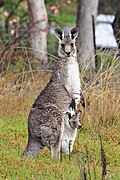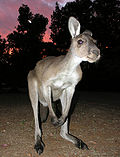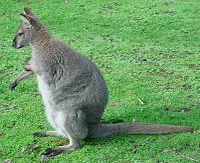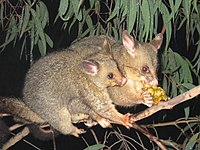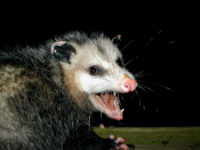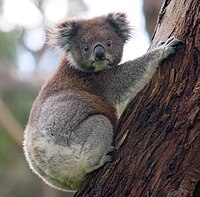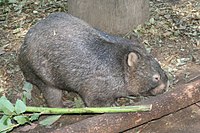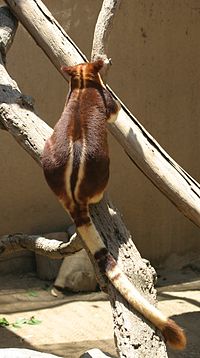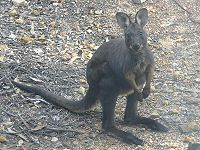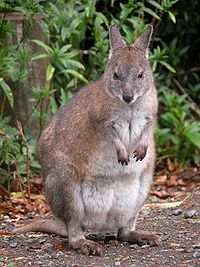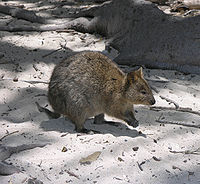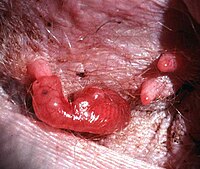Difference between revisions of "AY Honors/Marsupials/Answer Key"
m (Transwiki:Tasmanian Devil moved to AY Honor Marsupials: transwiki merge) |
m (- Category of AYHAB) |
||
| (70 intermediate revisions by 8 users not shown) | |||
| Line 1: | Line 1: | ||
| − | {{ | + | {{HonorSubpage}} |
| − | {{ | + | <!--{{Honor_Master|honor=Marsupials|master=Naturalist|group=Fauna}}--> |
| − | | | + | <!--{{Honor_Master|honor=Marsupials|master=Zoology|group=Fauna}}--> |
| − | | | + | <section begin="Body" /> |
| − | | | + | {{ansreq|page={{#titleparts:{{PAGENAME}}|2|1}}|num=1}} |
| − | | | + | <noinclude><translate><!--T:55--> |
| − | | | + | </noinclude> |
| − | | | + | <!-- 1. Distinguish: --> |
| − | | | + | <noinclude></translate></noinclude> |
| − | | | + | {{ansreq|page={{#titleparts:{{PAGENAME}}|2|1}}|num=1a}} |
| − | + | <noinclude><translate><!--T:56--> | |
| − | + | </noinclude> | |
| − | + | The mammals are the class of vertebrate animals characterized by the presence of mammary glands, which in females produce milk for the nourishment of young. | |
| − | |||
| − | | | ||
| − | | | ||
| − | | | ||
| − | | | ||
| − | }} | ||
| − | The | ||
| − | + | <!--T:57--> | |
| + | <noinclude></translate></noinclude> | ||
| + | {{CloseReq}} <!-- 1a --> | ||
| + | {{ansreq|page={{#titleparts:{{PAGENAME}}|2|1}}|num=1b}} <!--T:4--> | ||
| + | <noinclude><translate><!--T:58--> | ||
| + | </noinclude> | ||
| + | ;Placentals: The placentals are distinguished from other mammals in that the fetus is nourished during pregnancy via a placenta. | ||
| − | + | <!--T:5--> | |
| + | ;Marsupials:Marsupials are mammals in which the female typically has a pouch (called the marsupium) in which it rears its young through early infancy. They differ from placental mammals in their reproductive traits. | ||
| − | + | <!--T:6--> | |
| + | ;Monotremes: Monotremes are mammals that lay eggs instead of giving birth to live young like marsupials and placental mammals. | ||
| − | + | <!--T:59--> | |
| − | + | <noinclude></translate></noinclude> | |
| − | + | {{CloseReq}} <!-- 1b --> | |
| + | {{CloseReq}} <!-- 1 --> | ||
| + | {{ansreq|page={{#titleparts:{{PAGENAME}}|2|1}}|num=2}} | ||
| + | <noinclude><translate><!--T:60--> | ||
| + | </noinclude> | ||
| + | <!-- 2. Understand how marsupials are classified into families and describe, in a general way, the habits of these families. --> | ||
| + | Marsupials are classed mainly by their dietary habits. | ||
| + | ;Herbivorous marsupials: (such as kangaroos, wallabies, koalas, wombats, and possums) eat only plants. | ||
| + | ;Carnivorous marsupials: (such as Tasmanian devils, numbats, and quolls) eat only meat. They are very similar to one another in shape, though their sizes vary considerably. | ||
| + | ;Omnivorous Marsupials: (such as opossums) eat just about anything they can find. | ||
| − | + | <!--T:61--> | |
| + | <noinclude></translate></noinclude> | ||
| + | {{CloseReq}} <!-- 2 --> | ||
| + | {{ansreq|page={{#titleparts:{{PAGENAME}}|2|1}}|num=3}} | ||
| + | <noinclude><translate><!--T:62--> | ||
| + | </noinclude> | ||
| + | <!-- 3. Describe the distribution, habitat (ie. type of country they live in), diet breeding behavior, as well as any other interesting information of twelve different groups of marsupials and monotremes. --> | ||
| − | == | + | ===Tasmanian Devil=== <!--T:9--> |
| − | [[Image: | + | [[Image:Tasdevil large.jpg|thumb|200px]] |
| − | + | The Tasmanian Devil (''Sarcophilus harrisii''), also referred to simply as "the devil", is a carnivorous marsupial now found in the wild only in the Australian island state of Tasmania. The Tasmanian Devil is the only extant member of the genus ''Sarcophilus''. The size of a small dog, but stocky and muscular, the Tasmanian Devil is now the largest carnivorous marsupial in the world after the extinction of the Thylacine in 1936. It is characterised by its black fur, offensive odor when stressed, extremely loud and disturbing screech, and viciousness when feeding. It is known to both hunt prey and scavenge carrion and although it is usually solitary, it sometimes eats with other devils. | |
| − | + | <!--T:10--> | |
| + | The Tasmanian Devil became extirpated on the Australian mainland about 400 years before European settlement in 1788. Because they were seen as a threat to livestock in Tasmania, devils were hunted until 1941, when they became officially protected. Since the late 1990s devil facial tumour disease has reduced the devil population significantly and now threatens the survival of the species, which in May of 2008 was finally declared to be endangered. Programs are currently being undertaken by the Tasmanian government to reduce the impact of the disease. | ||
| − | + | <!--T:11--> | |
| − | + | Tasmanian Devils can take prey up to the size of a small wallaby, but in practice they are opportunistic, and eat carrion more often than they hunt live prey. Although the devil favours wombats, it will eat all small native mammals, domestic mammals (including sheep), birds, fish, insects, frogs and reptiles. Their diet is largely varied and depends on the food available. On average, they eat about 15% of their body weight each day; however, they can eat up to 40% of their body weight in 30 minutes if the opportunity arises. Tasmanian Devils eliminate all traces of a carcass, devouring the bones and fur in addition to the meat and internal organs. In this respect, the devil has earned the gratitude of Tasmanian farmers, as the speed at which they clean a carcass helps prevent the spread of insects that might otherwise harm livestock. | |
| + | {{clear}} | ||
| − | [[Image: | + | ===Numbat=== <!--T:12--> |
| + | [[Image:Numbat.jpg|thumb|200px]] | ||
| + | The Numbat is a small, colorful creature between 20 and a little under 30 cm long, with a finely pointed muzzle and a prominent, bushy tail about the same length as its body. Color varies considerably, from soft grey to reddish-brown, often with an area of brick red on the upper back, and always with a conspicuous black stripe running from the tip of the muzzle through the eyes to the bases of the small, round-tipped ears. The underside is cream or light grey; weight varies between 280 and 550 grams. | ||
| − | + | <!--T:13--> | |
| + | Adult Numbats are solitary and territorial; an individual of either sex establishes a territory of up to 150 hectares (370 acres)[4] early in life, and defends it from others of the same sex. The animal generally remains within it from that time on; male and female territories overlap, and in the breeding season males will venture outside their normal home range to find mates. | ||
| − | + | <!--T:14--> | |
| − | + | Another common name for the Numbat was Banded Anteater, though this has now fallen into disuse. Though it will in fact consume ants, its diet otherwise consists almost exclusively of termites. | |
| − | + | <!--T:15--> | |
| + | While the numbat has relatively powerful claws for its size,[4] it is not strong enough to get at termites inside the concrete-like mound, and so must wait until the termites are active. It uses a well-developed sense of smell to locate the shallow and unfortified underground galleries that termites construct between the nest and their feeding sites; these are usually only a short distance below the surface of the soil, and vulnerable to the Numbat's digging claws. | ||
| + | {{clear}} | ||
| − | |||
| − | |||
| − | |||
| − | |||
| − | |||
| − | + | ===Quoll=== <!--T:16--> | |
| + | [[Image:SpottedQuoll 2005 SeanMcClean.jpg|thumb|200px]] | ||
| + | Quolls or native cats (genus ''Dasyurus'') are carnivorous marsupials, native to Australia and Papua New Guinea. Adults are between 25 and 75 cm long, with hairy tails about 20-35 cm long. Females have six to eight nipples and develop a pouch—which opens towards the tail—only during the breeding season, when they are rearing young. The babies are the size of a grain of rice. Quolls live both in forests and in open valley land. Though primarily ground-dwelling, they have developed secondary arboreal characteristics. They do not have prehensile tails, but do have ridges on the pads of their feet. Their molars and canines are strongly developed. | ||
| − | + | <!--T:17--> | |
| + | The Eastern Quoll is a solitary predator, hunting at night for its prey of insects and small mammals. They have also been known to scavenge food from the much larger Tasmanian Devil. | ||
| − | + | <!--T:18--> | |
| + | The breeding season begins in early winter, and the female gives birth to up to 30 young. Of these, the first to attach themselves to the six teats will be the only survivors. Weaning takes place at about 10 weeks of age, with the young staying in the den while the mother forages. | ||
| − | + | <!--T:19--> | |
| − | + | {{clear}} | |
| − | |||
| − | + | ===Kangaroos=== <!--T:20--> | |
| + | <gallery perrow=3 heights=200px> | ||
| + | Image:Red kangaroo - melbourne zoo.jpg|<center>Red Kangaroo</center> | ||
| + | Image:Kangaroo and joey03.jpg|<center>Eastern Grey Kanagroo</center> | ||
| + | Image:Western Grey Kangaroo SMC 2006.JPG|<center>Western Grey Kangaroo</center> | ||
| + | </gallery> | ||
| − | The | + | <!--T:21--> |
| + | There are three species of kangaroo: | ||
| + | * The '''Red Kangaroo''' (''Macropus rufus'') is the largest surviving marsupial anywhere in the world. Fewer in numbers, the Red Kangaroos occupy the arid and semi-arid centre of the continent. A large male can be 2 metres (6 ft 7 in) tall and weigh 90 kg (200 lb). | ||
| + | * The '''Eastern Grey Kangaroo''' (''Macropus giganteus'') is less well-known than the red (outside of Australia), but the most often seen, as its range covers the fertile eastern part of the continent. | ||
| + | * The '''Western Grey Kangaroo''' (''Macropus fuliginosus'') is slightly smaller again at about 54 kg (119 lb) for a large male. It is found in the southern part of Western Australia, South Australia near the coast, and the Darling River basin. | ||
| − | == | + | ===Wallabies=== <!--T:22--> |
| − | {{ | + | [[Image:Red-necked-Wallaby.jpg|thumb|200px]] |
| − | + | Essentially, a wallaby is any macropod that isn't large enough to be considered a kangaroo and has not been given some other name. There is no fixed dividing line. In general, a wallaby is smaller and has a stockier build than a kangaroo; a wallaroo is any of a few species somewhat intermediate in size between a wallaby and a kangaroo. | |
| − | + | {{clear}} | |
| + | ===Possums=== | ||
| + | [[Image:Brushtail possum.jpg|thumb|200px]] | ||
| + | Possums are small marsupials with brown or grey fur, ranging in size from the length of a finger (pygmy possums and wrist-winged gliders), to the length of a forearm (brushtails and ringtails). All possums are nocturnal and omnivorous, hiding in a nest in a hollow tree during the day and coming out during the night to forage for food. They fill much the same role in the Australian ecosystem that squirrels fill in the northern hemisphere and are broadly similar in appearance. | ||
| + | <!--T:23--> | ||
| + | The two most common species of possums, the Common Brushtail and Common Ringtail, are also among the largest. | ||
| + | {{clear}} | ||
| − | == | + | ===Opossums=== <!--T:24--> |
| − | <!-- | + | [[Image:AwesomePossum-AmericanOpossum.jpg|thumb|200px]] |
| − | + | Opossums are nocturnal marsupials found in the Western Hemisphere. They are small to medium-sized creatures, about the size of a large house cat. Although there are many exceptions, most of them spend time living both in trees and on the ground, and they eat many different things (plants and animals). | |
| − | + | <!--T:25--> | |
| − | + | Opossums are usually nomadic, staying in one area as long as food and water are easily available. Though they will temporarily occupy abandoned burrows, they do not dig or put much effort into building their own. They favor dark, secure areas, below ground or above. | |
| − | |||
| − | |||
| − | |||
| − | |||
| − | |||
| − | + | When threatened or harmed, they will "play possum", mimicking the appearance and smell of a sick or dead animal. The lips are drawn back, teeth are bared, saliva foams around the mouth, and a foul-smelling fluid is secreted from glands. This response is involuntary, rather than a conscious act. Their stiff, curled form can be prodded, turned over, and even carried away. Many injured opossums have been killed by well-meaning people who find a catatonic animal and assume the worst. If you find an injured or apparently dead opossum, the best thing to do is leave it in a quiet place with a clear exit path. In minutes or hours, the animal will regain consciousness and escape quietly on its own. | |
| − | {{ | + | {{clear}} |
| + | ===Shrew Opossums=== <!--T:26--> | ||
| + | [[Image:Shrew opossum - Caenolestidae.png|thumb|200px]] | ||
| + | Shrew opossums (also known as rat opossums) are about the size of a small rat (9–14 cm long), with thin limbs, a long, pointed snout and a slender, hairy tail. They are largely meat-eaters, being active hunters of insects, earthworms and small vertebrates. They have small eyes and poor sight, and hunt in the early evening and at night, using their hearing and long, sensitive whiskers to locate prey. They seem to spend much of their lives in underground burrows and on surface runways. | ||
| − | + | Largely because of their rugged, inaccessible habitat, they are very poorly known and have traditionally been considered rare. Recent studies suggest that they may be more common than had been thought. | |
| − | [[ | + | {{clear}} |
| − | + | ===Koalas=== <!--T:27--> | |
| − | + | [[Image:Koala climbing tree.jpg|thumb|200px]] | |
| − | [[ | + | The Koala is broadly similar in appearance to the wombat, but has a thicker, more luxurious coat, much larger ears, and longer limbs, which are equipped with large, sharp claws to assist with climbing. Weight varies from about 14 kg for a large, southern male, to about 5 kg for a small northern female. Contrary to popular belief, their fur is thick, not soft and cuddly. Koalas' five fingers per paw are arranged with the first two as opposable thumbs, providing better gripping ability. |
| − | + | {{clear}} | |
| + | ===Wombats=== | ||
| + | [[Image:Wombat at Lone Pine.jpg|thumb|200px]] | ||
| + | Wombats are Australian marsupials; they are short-legged, muscular quadrupeds, approximately one meter (3 feet) in length and with a very short tail. Wombats have an extraordinarily slow metabolism, taking around 14 days to complete digestion, and generally move slowly. When required, however, they can reach up to 40 km/h and maintain that speed for up to 90 seconds. | ||
| − | {{ | + | When attacked, they can summon immense reserves of strength — one defense of a wombat against a predator (such as a Dingo) underground is to crush it against the roof of the tunnel until it stops breathing. |
| − | {{ | + | {{clear}} |
| − | [[ | + | ===Tree-kangaroo=== <!--T:28--> |
| − | + | [[Image:Buergers' Tree-kangaroo back and tail.jpg|thumb|200px]] | |
| − | + | Tree-kangaroos are macropods adapted for life in trees. They are found in the rainforests of New Guinea, far northeastern Queensland, and nearby islands, usually in mountainous areas. Although most are found in mountainous areas, several species also occur in lowlands, and one, the aptly named Lowlands Tree-kangaroo, appears to be restricted to lowlands. | |
| − | [[ | + | |
| − | + | <!--T:29--> | |
| − | + | Tree-kangaroos feed mostly on leaves and fruit, taken both in trees and on the ground, but other foods are eaten when available, including grain, flowers, sap, bark, eggs and young birds. Their teeth are adapted for tearing leaves rather than cutting grass. | |
| − | + | {{clear}} | |
| − | + | ||
| − | + | ===Wallaroo=== <!--T:30--> | |
| − | + | [[Image:Macropus robustus.jpg|thumb|200px]] | |
| − | [[ | + | A wallaroo is any of three closely related species of moderately large macropod, intermediate in size between the kangaroos and the wallabies. The name "wallaroo" is a portmanteau of wallaby and kangaroo. In general, a large, slim-bodied macropod of the open plains is called a "kangaroo"; a small to medium-sized one, particularly if it is relatively thick-set, is a "wallaby": most wallaroos are only a little smaller than a kangaroo, fairly thickset, and are found in open country. All share a particular habit of stance: wrists raised, elbows tucked close into the body, and shoulders thrown back, and all have a large, black-skinned rhinarium. |
| − | + | ||
| − | + | <!--T:31--> | |
| − | + | The best-known species is ''Macropus robustus'', which is known as the Eastern Wallaroo, Common Wallaroo or just Wallaroo on the slopes of the Great Dividing Range (which runs for more than 3,000 km around the eastern and south-eastern coast of Australia), and as the Euro in most of the rest of the continent. There are four subspecies: the Eastern Wallaroo and the Euro, which are both widespread, and two of more restricted range, one from Barrow Island, the other from the Kimberley. | |
| − | + | ||
| − | + | <!--T:32--> | |
| − | + | The Black Wallaroo (''Macropus bernardus'') occupies an area of steep, rocky ground in Arnhem Land. At around 60 to 70 cm in length (excluding tail) it is the smallest wallaroo and the most heavily built. Males weigh 19 to 22 kg, females about 13 kg. Because it is very wary and is found only in a small area of remote and very rugged country, it is remarkably little known. | |
| − | + | ||
| − | + | The Antilopine Wallaroo (''Macropus antilopinus'') is the exception among wallaroos. It is, essentially, the far-northern equivalent of the Eastern and Western Grey Kangaroos. Like them, it is a creature of the grassy plains and woodlands, and gregarious, where the other wallaroos are solitary. Because of this difference, it is sometimes called the Antilopine Kangaroo. | |
| − | + | ===Pademelon=== <!--T:33--> | |
| − | [[ | + | [[Image:RedNeckedPademelon-front-800.jpg|thumb|200px]] |
| − | + | A pademelon is any of seven species of small marsupials of the genus ''Thylogale''. They are usually found in forests. Pademelons are the smallest of the macropods. The name is a corruption of badimaliyan, from the Dharuk Aboriginal language of Port Jackson. | |
| − | + | ||
| − | + | <!--T:34--> | |
| − | + | Pademelons, wallabies, and kangaroos are very alike in body structure, and the names just refer to the three different size groups. Originally wallabies were divided into small and large wallabies, but a more suitable name was needed to differentiate between them. | |
| − | + | ||
| − | + | <!--T:35--> | |
| − | + | Besides their smaller size, pademelons can be distinguished from wallabies by their shorter, thicker, and sparsely haired tails. | |
| + | |||
| + | <!--T:36--> | ||
| + | If there are no predators, such as dogs, they graze in the early mornings or evenings on grassy slopes near thickets into which they can quickly escape at the first sign of danger. Having noticed danger, such as a python, they may try to warn others by stomping their feet on the ground producing surprisingly loud sound. Pademelons are nocturnal and tend to feed at night. | ||
| + | |||
| + | <!--T:37--> | ||
| + | Their main diet is made up of grasses, leaves, and small shoots. They do little damage to crops and are not as aggressive as wallabies and kangaroos can be, making them gentle pets. | ||
| + | |||
| + | <!--T:38--> | ||
| + | Normally, a group of females would stay on the territory with males showing up, only when one of the females is ready for mating. This is in contrast to the behavior of bigger kangaroos, who stay in mixed mobs with a male leader. | ||
| + | {{clear}} | ||
| + | |||
| + | ===Quokka=== <!--T:39--> | ||
| + | [[Image:Rottnest Quokka 2004 SeanMcClean.jpg|thumb|200px]] | ||
| + | The Quokka (''Setonix brachyurus''), the only member of the genus ''Setonix'', is a small macropod about the size of a large domestic cat. Like other marsupials in the macropod family (such as the kangaroos and wallabies), the Quokka is herbivorous and mainly nocturnal. | ||
| + | |||
| + | <!--T:40--> | ||
| + | In the wild, its roaming is restricted to a very small range in the South-West of Western Australia. The Quokka has become rare, but remains a protected species on islands off the coast of that area, Bald Island, Rottnest Island, Garden Island and rarely Penguin Island. The islands are free of foxes and cats. On Rottnest Island, it is common and occupies a wide range of habitats, ranging from semi-arid scrub to cultivated gardens. | ||
| + | |||
| + | <!--T:41--> | ||
| + | The Quokka is gregarious and gathers in large groups where food is available: primary items are grasses, sedges, succulents and foliage. The health of some animals has suffered significantly by the ingestion of inappropriate foods, such as bread, given by well meaning visitors to Rottnest Island. Visitors are now asked to refrain from feeding them. It breeds at any time on the mainland, but in late summer on Rottnest. The Quokka only produces a single joey in a year. Restricted availability of the trace element copper appears to be a major limiting factor of the ability of the Quokka to breed on Rottnest. | ||
| + | |||
| + | <!--T:42--> | ||
| + | The Quokka's movements are similar to a kangaroo, using mixture of small and large hops. | ||
| + | |||
| + | <!--T:63--> | ||
| + | <noinclude></translate></noinclude> | ||
| + | {{CloseReq}} <!-- 3 --> | ||
| + | {{ansreq|page={{#titleparts:{{PAGENAME}}|2|1}}|num=4}} | ||
| + | <noinclude><translate><!--T:64--> | ||
| + | </noinclude> | ||
| + | <!-- 4. Be able to explain the difference between marsupial reproduction and that in true mammals (ie. placentals). --> | ||
| + | The pregnant female marsupial develops a kind of yolk sack in her womb which delivers nutrients to the embryo. The embryo is born at a very early stage of development (at about 4-5 weeks), upon which it crawls up its mother's belly and attaches itself to a nipple (which is located inside the pouch). It remains attached to the nipple for a number of weeks. The offspring later passes through a stage where it temporarily leaves the pouch, returning for warmth and nourishment. | ||
| + | |||
| + | <!--T:44--> | ||
| + | The placenta is a temporary organ composed of two parts, one of which is part of the fetus, the other part of the mother. It is implanted in the wall of the uterus, where it receives nutrients and oxygen from the mother's blood and passes out waste. This interface forms a barrier, the placental barrier, which filters out some substances which could harm the fetus. | ||
| + | |||
| + | <!--T:65--> | ||
| + | <noinclude></translate></noinclude> | ||
| + | {{CloseReq}} <!-- 4 --> | ||
| + | {{ansreq|page={{#titleparts:{{PAGENAME}}|2|1}}|num=5}} | ||
| + | <noinclude><translate><!--T:66--> | ||
| + | </noinclude> | ||
| + | <!-- 5. Explain the significance of the direction of opening of the pouch and the number of young per litter in marsupials. --> | ||
| + | [[Image:Joey in pouch.jpg|thumb|200px|Kangaroo joey inside the pouch]] | ||
| + | The pouch is a distinguishing feature of female marsupials; the name marsupial is derived from the Latin marsupium, meaning pouch. Marsupials give birth to a live but relatively undeveloped fetus called a joey. When the joey is born it crawls from inside the mother to the pouch. The pouch is basically a fold of skin with a single opening that covers the nipples to protect the joey as it continues to develop. | ||
| + | |||
| + | <!--T:46--> | ||
| + | Pouches are different amongst the different marsupials: for example for Quolls and Tasmanian Devils, the pouch opens to the rear and the joey only has to travel a short distance to get to the opening of the pouch. While in the pouch they are permanently attached to the nipple and once the young have developed they leave the pouch and do not return. The kangaroo's pouch opens horizontally on the front of the body, and the joey must climb a relatively long way to reach it. Kangaroos and wallabies allow their young to live in the pouch well after they are physically capable of leaving. | ||
| + | |||
| + | <!--T:47--> | ||
| + | Tasmanian Devils give birth to up to 50 young, each weighing approximately 0.18–0.24 grams. When the young are born, they move from the vagina to the pouch. Once inside the pouch, they each remain attached to a nipple for the next 100 days. Despite the large litter at birth, the female has only four nipples, so that no more than four young can survive birth. On average, more females survive than males. The female Tasmanian Devil's pouch, like that of the wombat, opens to the rear, so it is physically difficult for the female to interact with young inside the pouch. Unlike kangaroo joeys, young devils (and other marsupials with rear-opening pouches) do not return to the pouch; instead, they remain in the den for another three months, first venturing outside the den between October and December before becoming independent in January. | ||
| + | |||
| + | <!--T:67--> | ||
| + | <noinclude></translate></noinclude> | ||
| + | {{CloseReq}} <!-- 5 --> | ||
| + | {{ansreq|page={{#titleparts:{{PAGENAME}}|2|1}}|num=6}} | ||
| + | <noinclude><translate><!--T:68--> | ||
| + | </noinclude> | ||
| + | <!-- 6. Give an explanation of the unique occurrence of marsupials in Australia. --> | ||
| + | Marsupial success in Australia has been attributed to the lack of placental mammals living there. When marsupials and placental mammals share an environment, the placental mammals typically outcompete the marsupials and the marsupials do not survive. | ||
| + | |||
| + | <!--T:49--> | ||
| + | It has also been suggested that since marsupials have a lower metabolic rate, they are better able to survive the heat of Australia. However, this conjecture does not account for the success of placental mammals in other hot climates such as Africa and India. Furthermore, placental mammals, when introduced to Australia, repeatedly demonstrate their fitness to Australia's climate by outcompeting the marsupials. | ||
| + | |||
| + | <!--T:69--> | ||
| + | <noinclude></translate></noinclude> | ||
| + | {{CloseReq}} <!-- 6 --> | ||
| + | {{ansreq|page={{#titleparts:{{PAGENAME}}|2|1}}|num=7}} | ||
| + | <noinclude><translate><!--T:70--> | ||
| + | </noinclude> | ||
| + | <!-- 7. Be able to explain the need for conservation of our marsupials. --> | ||
| + | Many marsupials have been listed as endangered species. Until the Europeans arrived in Australia, it was an isolated continent and no placental mammals (other than man) were able to travel there. When the Europeans arrived on ships, they brought placental mammals with them - sometimes intentionally, as in the case of cattle and sheep, and sometimes unintentionally, as in the case of rats and mice. These placental mammals pose a great threat to the native marsupials, as they compete for the same resources, often displacing them. | ||
| + | |||
| + | <!--T:71--> | ||
| + | <noinclude></translate></noinclude> | ||
| + | {{CloseReq}} <!-- 7 --> | ||
| + | {{ansreq|page={{#titleparts:{{PAGENAME}}|2|1}}|num=8}} | ||
| + | <noinclude><translate><!--T:72--> | ||
| + | </noinclude> | ||
| + | <!-- 8. Write a report of your visit to a natural history museum, wild-life sanctuary, zoo, etc. indicating in about 10-15 lines, the extent of your observations. --> | ||
| + | The place you visit should presumably have some marsupials in its collection, and the 10-15 lines should document observations of the marsupials. Here are some ideas for the sorts of things you might be looking for: | ||
| + | |||
| + | <!--T:52--> | ||
| + | *'''Species:''' what is the name of this marsupial? What is its scientific name? | ||
| + | *'''Natural habitat:''' where does this animal live in the wild? | ||
| + | *'''Artificial habitat:''' how were its needs being met (if it was a live animal) | ||
| + | *'''Diet:''' How does its natural diet compare to its diet in the sanctuary or zoo? | ||
| + | *'''Conservation Status:''' is this animal threatened or endangered? If so, what is being done to conserve it? | ||
| + | *'''Breeding:''' Were the animals in this collection part of a breeding program? | ||
| + | *'''Young:''' Did you see any young marsupials? Were they in their mother's pouch? | ||
| + | *'''Unique Features:''' what is unique about this animal? | ||
| + | *'''Fascinating Features:''' what did you like best about this animal? | ||
| + | |||
| + | <!--T:53--> | ||
| + | {{AY Honors/Zoo Visit}} | ||
| + | |||
| + | <!--T:73--> | ||
| + | <noinclude></translate></noinclude> | ||
| + | {{CloseReq}} <!-- 8 --> | ||
| + | <noinclude><translate></noinclude> | ||
| + | ==References== <!--T:54--> | ||
| + | <noinclude></translate></noinclude> | ||
| + | {{CloseHonorPage}} | ||
Latest revision as of 16:02, 14 July 2022
1
1a
The mammals are the class of vertebrate animals characterized by the presence of mammary glands, which in females produce milk for the nourishment of young.
1b
- Placentals
- The placentals are distinguished from other mammals in that the fetus is nourished during pregnancy via a placenta.
- Marsupials
- Marsupials are mammals in which the female typically has a pouch (called the marsupium) in which it rears its young through early infancy. They differ from placental mammals in their reproductive traits.
- Monotremes
- Monotremes are mammals that lay eggs instead of giving birth to live young like marsupials and placental mammals.
2
Marsupials are classed mainly by their dietary habits.
- Herbivorous marsupials
- (such as kangaroos, wallabies, koalas, wombats, and possums) eat only plants.
- Carnivorous marsupials
- (such as Tasmanian devils, numbats, and quolls) eat only meat. They are very similar to one another in shape, though their sizes vary considerably.
- Omnivorous Marsupials
- (such as opossums) eat just about anything they can find.
3
Tasmanian Devil
The Tasmanian Devil (Sarcophilus harrisii), also referred to simply as "the devil", is a carnivorous marsupial now found in the wild only in the Australian island state of Tasmania. The Tasmanian Devil is the only extant member of the genus Sarcophilus. The size of a small dog, but stocky and muscular, the Tasmanian Devil is now the largest carnivorous marsupial in the world after the extinction of the Thylacine in 1936. It is characterised by its black fur, offensive odor when stressed, extremely loud and disturbing screech, and viciousness when feeding. It is known to both hunt prey and scavenge carrion and although it is usually solitary, it sometimes eats with other devils.
The Tasmanian Devil became extirpated on the Australian mainland about 400 years before European settlement in 1788. Because they were seen as a threat to livestock in Tasmania, devils were hunted until 1941, when they became officially protected. Since the late 1990s devil facial tumour disease has reduced the devil population significantly and now threatens the survival of the species, which in May of 2008 was finally declared to be endangered. Programs are currently being undertaken by the Tasmanian government to reduce the impact of the disease.
Tasmanian Devils can take prey up to the size of a small wallaby, but in practice they are opportunistic, and eat carrion more often than they hunt live prey. Although the devil favours wombats, it will eat all small native mammals, domestic mammals (including sheep), birds, fish, insects, frogs and reptiles. Their diet is largely varied and depends on the food available. On average, they eat about 15% of their body weight each day; however, they can eat up to 40% of their body weight in 30 minutes if the opportunity arises. Tasmanian Devils eliminate all traces of a carcass, devouring the bones and fur in addition to the meat and internal organs. In this respect, the devil has earned the gratitude of Tasmanian farmers, as the speed at which they clean a carcass helps prevent the spread of insects that might otherwise harm livestock.
Numbat
The Numbat is a small, colorful creature between 20 and a little under 30 cm long, with a finely pointed muzzle and a prominent, bushy tail about the same length as its body. Color varies considerably, from soft grey to reddish-brown, often with an area of brick red on the upper back, and always with a conspicuous black stripe running from the tip of the muzzle through the eyes to the bases of the small, round-tipped ears. The underside is cream or light grey; weight varies between 280 and 550 grams.
Adult Numbats are solitary and territorial; an individual of either sex establishes a territory of up to 150 hectares (370 acres)[4] early in life, and defends it from others of the same sex. The animal generally remains within it from that time on; male and female territories overlap, and in the breeding season males will venture outside their normal home range to find mates.
Another common name for the Numbat was Banded Anteater, though this has now fallen into disuse. Though it will in fact consume ants, its diet otherwise consists almost exclusively of termites.
While the numbat has relatively powerful claws for its size,[4] it is not strong enough to get at termites inside the concrete-like mound, and so must wait until the termites are active. It uses a well-developed sense of smell to locate the shallow and unfortified underground galleries that termites construct between the nest and their feeding sites; these are usually only a short distance below the surface of the soil, and vulnerable to the Numbat's digging claws.
Quoll
Quolls or native cats (genus Dasyurus) are carnivorous marsupials, native to Australia and Papua New Guinea. Adults are between 25 and 75 cm long, with hairy tails about 20-35 cm long. Females have six to eight nipples and develop a pouch—which opens towards the tail—only during the breeding season, when they are rearing young. The babies are the size of a grain of rice. Quolls live both in forests and in open valley land. Though primarily ground-dwelling, they have developed secondary arboreal characteristics. They do not have prehensile tails, but do have ridges on the pads of their feet. Their molars and canines are strongly developed.
The Eastern Quoll is a solitary predator, hunting at night for its prey of insects and small mammals. They have also been known to scavenge food from the much larger Tasmanian Devil.
The breeding season begins in early winter, and the female gives birth to up to 30 young. Of these, the first to attach themselves to the six teats will be the only survivors. Weaning takes place at about 10 weeks of age, with the young staying in the den while the mother forages.
Kangaroos
There are three species of kangaroo:
- The Red Kangaroo (Macropus rufus) is the largest surviving marsupial anywhere in the world. Fewer in numbers, the Red Kangaroos occupy the arid and semi-arid centre of the continent. A large male can be 2 metres (6 ft 7 in) tall and weigh 90 kg (200 lb).
- The Eastern Grey Kangaroo (Macropus giganteus) is less well-known than the red (outside of Australia), but the most often seen, as its range covers the fertile eastern part of the continent.
- The Western Grey Kangaroo (Macropus fuliginosus) is slightly smaller again at about 54 kg (119 lb) for a large male. It is found in the southern part of Western Australia, South Australia near the coast, and the Darling River basin.
Wallabies
Essentially, a wallaby is any macropod that isn't large enough to be considered a kangaroo and has not been given some other name. There is no fixed dividing line. In general, a wallaby is smaller and has a stockier build than a kangaroo; a wallaroo is any of a few species somewhat intermediate in size between a wallaby and a kangaroo.
Possums
Possums are small marsupials with brown or grey fur, ranging in size from the length of a finger (pygmy possums and wrist-winged gliders), to the length of a forearm (brushtails and ringtails). All possums are nocturnal and omnivorous, hiding in a nest in a hollow tree during the day and coming out during the night to forage for food. They fill much the same role in the Australian ecosystem that squirrels fill in the northern hemisphere and are broadly similar in appearance.
The two most common species of possums, the Common Brushtail and Common Ringtail, are also among the largest.
Opossums
Opossums are nocturnal marsupials found in the Western Hemisphere. They are small to medium-sized creatures, about the size of a large house cat. Although there are many exceptions, most of them spend time living both in trees and on the ground, and they eat many different things (plants and animals).
Opossums are usually nomadic, staying in one area as long as food and water are easily available. Though they will temporarily occupy abandoned burrows, they do not dig or put much effort into building their own. They favor dark, secure areas, below ground or above.
When threatened or harmed, they will "play possum", mimicking the appearance and smell of a sick or dead animal. The lips are drawn back, teeth are bared, saliva foams around the mouth, and a foul-smelling fluid is secreted from glands. This response is involuntary, rather than a conscious act. Their stiff, curled form can be prodded, turned over, and even carried away. Many injured opossums have been killed by well-meaning people who find a catatonic animal and assume the worst. If you find an injured or apparently dead opossum, the best thing to do is leave it in a quiet place with a clear exit path. In minutes or hours, the animal will regain consciousness and escape quietly on its own.
Shrew Opossums
Shrew opossums (also known as rat opossums) are about the size of a small rat (9–14 cm long), with thin limbs, a long, pointed snout and a slender, hairy tail. They are largely meat-eaters, being active hunters of insects, earthworms and small vertebrates. They have small eyes and poor sight, and hunt in the early evening and at night, using their hearing and long, sensitive whiskers to locate prey. They seem to spend much of their lives in underground burrows and on surface runways.
Largely because of their rugged, inaccessible habitat, they are very poorly known and have traditionally been considered rare. Recent studies suggest that they may be more common than had been thought.
Koalas
The Koala is broadly similar in appearance to the wombat, but has a thicker, more luxurious coat, much larger ears, and longer limbs, which are equipped with large, sharp claws to assist with climbing. Weight varies from about 14 kg for a large, southern male, to about 5 kg for a small northern female. Contrary to popular belief, their fur is thick, not soft and cuddly. Koalas' five fingers per paw are arranged with the first two as opposable thumbs, providing better gripping ability.
Wombats
Wombats are Australian marsupials; they are short-legged, muscular quadrupeds, approximately one meter (3 feet) in length and with a very short tail. Wombats have an extraordinarily slow metabolism, taking around 14 days to complete digestion, and generally move slowly. When required, however, they can reach up to 40 km/h and maintain that speed for up to 90 seconds.
When attacked, they can summon immense reserves of strength — one defense of a wombat against a predator (such as a Dingo) underground is to crush it against the roof of the tunnel until it stops breathing.
Tree-kangaroo
Tree-kangaroos are macropods adapted for life in trees. They are found in the rainforests of New Guinea, far northeastern Queensland, and nearby islands, usually in mountainous areas. Although most are found in mountainous areas, several species also occur in lowlands, and one, the aptly named Lowlands Tree-kangaroo, appears to be restricted to lowlands.
Tree-kangaroos feed mostly on leaves and fruit, taken both in trees and on the ground, but other foods are eaten when available, including grain, flowers, sap, bark, eggs and young birds. Their teeth are adapted for tearing leaves rather than cutting grass.
Wallaroo
A wallaroo is any of three closely related species of moderately large macropod, intermediate in size between the kangaroos and the wallabies. The name "wallaroo" is a portmanteau of wallaby and kangaroo. In general, a large, slim-bodied macropod of the open plains is called a "kangaroo"; a small to medium-sized one, particularly if it is relatively thick-set, is a "wallaby": most wallaroos are only a little smaller than a kangaroo, fairly thickset, and are found in open country. All share a particular habit of stance: wrists raised, elbows tucked close into the body, and shoulders thrown back, and all have a large, black-skinned rhinarium.
The best-known species is Macropus robustus, which is known as the Eastern Wallaroo, Common Wallaroo or just Wallaroo on the slopes of the Great Dividing Range (which runs for more than 3,000 km around the eastern and south-eastern coast of Australia), and as the Euro in most of the rest of the continent. There are four subspecies: the Eastern Wallaroo and the Euro, which are both widespread, and two of more restricted range, one from Barrow Island, the other from the Kimberley.
The Black Wallaroo (Macropus bernardus) occupies an area of steep, rocky ground in Arnhem Land. At around 60 to 70 cm in length (excluding tail) it is the smallest wallaroo and the most heavily built. Males weigh 19 to 22 kg, females about 13 kg. Because it is very wary and is found only in a small area of remote and very rugged country, it is remarkably little known.
The Antilopine Wallaroo (Macropus antilopinus) is the exception among wallaroos. It is, essentially, the far-northern equivalent of the Eastern and Western Grey Kangaroos. Like them, it is a creature of the grassy plains and woodlands, and gregarious, where the other wallaroos are solitary. Because of this difference, it is sometimes called the Antilopine Kangaroo.
Pademelon
A pademelon is any of seven species of small marsupials of the genus Thylogale. They are usually found in forests. Pademelons are the smallest of the macropods. The name is a corruption of badimaliyan, from the Dharuk Aboriginal language of Port Jackson.
Pademelons, wallabies, and kangaroos are very alike in body structure, and the names just refer to the three different size groups. Originally wallabies were divided into small and large wallabies, but a more suitable name was needed to differentiate between them.
Besides their smaller size, pademelons can be distinguished from wallabies by their shorter, thicker, and sparsely haired tails.
If there are no predators, such as dogs, they graze in the early mornings or evenings on grassy slopes near thickets into which they can quickly escape at the first sign of danger. Having noticed danger, such as a python, they may try to warn others by stomping their feet on the ground producing surprisingly loud sound. Pademelons are nocturnal and tend to feed at night.
Their main diet is made up of grasses, leaves, and small shoots. They do little damage to crops and are not as aggressive as wallabies and kangaroos can be, making them gentle pets.
Normally, a group of females would stay on the territory with males showing up, only when one of the females is ready for mating. This is in contrast to the behavior of bigger kangaroos, who stay in mixed mobs with a male leader.
Quokka
The Quokka (Setonix brachyurus), the only member of the genus Setonix, is a small macropod about the size of a large domestic cat. Like other marsupials in the macropod family (such as the kangaroos and wallabies), the Quokka is herbivorous and mainly nocturnal.
In the wild, its roaming is restricted to a very small range in the South-West of Western Australia. The Quokka has become rare, but remains a protected species on islands off the coast of that area, Bald Island, Rottnest Island, Garden Island and rarely Penguin Island. The islands are free of foxes and cats. On Rottnest Island, it is common and occupies a wide range of habitats, ranging from semi-arid scrub to cultivated gardens.
The Quokka is gregarious and gathers in large groups where food is available: primary items are grasses, sedges, succulents and foliage. The health of some animals has suffered significantly by the ingestion of inappropriate foods, such as bread, given by well meaning visitors to Rottnest Island. Visitors are now asked to refrain from feeding them. It breeds at any time on the mainland, but in late summer on Rottnest. The Quokka only produces a single joey in a year. Restricted availability of the trace element copper appears to be a major limiting factor of the ability of the Quokka to breed on Rottnest.
The Quokka's movements are similar to a kangaroo, using mixture of small and large hops.
4
The pregnant female marsupial develops a kind of yolk sack in her womb which delivers nutrients to the embryo. The embryo is born at a very early stage of development (at about 4-5 weeks), upon which it crawls up its mother's belly and attaches itself to a nipple (which is located inside the pouch). It remains attached to the nipple for a number of weeks. The offspring later passes through a stage where it temporarily leaves the pouch, returning for warmth and nourishment.
The placenta is a temporary organ composed of two parts, one of which is part of the fetus, the other part of the mother. It is implanted in the wall of the uterus, where it receives nutrients and oxygen from the mother's blood and passes out waste. This interface forms a barrier, the placental barrier, which filters out some substances which could harm the fetus.
5
The pouch is a distinguishing feature of female marsupials; the name marsupial is derived from the Latin marsupium, meaning pouch. Marsupials give birth to a live but relatively undeveloped fetus called a joey. When the joey is born it crawls from inside the mother to the pouch. The pouch is basically a fold of skin with a single opening that covers the nipples to protect the joey as it continues to develop.
Pouches are different amongst the different marsupials: for example for Quolls and Tasmanian Devils, the pouch opens to the rear and the joey only has to travel a short distance to get to the opening of the pouch. While in the pouch they are permanently attached to the nipple and once the young have developed they leave the pouch and do not return. The kangaroo's pouch opens horizontally on the front of the body, and the joey must climb a relatively long way to reach it. Kangaroos and wallabies allow their young to live in the pouch well after they are physically capable of leaving.
Tasmanian Devils give birth to up to 50 young, each weighing approximately 0.18–0.24 grams. When the young are born, they move from the vagina to the pouch. Once inside the pouch, they each remain attached to a nipple for the next 100 days. Despite the large litter at birth, the female has only four nipples, so that no more than four young can survive birth. On average, more females survive than males. The female Tasmanian Devil's pouch, like that of the wombat, opens to the rear, so it is physically difficult for the female to interact with young inside the pouch. Unlike kangaroo joeys, young devils (and other marsupials with rear-opening pouches) do not return to the pouch; instead, they remain in the den for another three months, first venturing outside the den between October and December before becoming independent in January.
6
Marsupial success in Australia has been attributed to the lack of placental mammals living there. When marsupials and placental mammals share an environment, the placental mammals typically outcompete the marsupials and the marsupials do not survive.
It has also been suggested that since marsupials have a lower metabolic rate, they are better able to survive the heat of Australia. However, this conjecture does not account for the success of placental mammals in other hot climates such as Africa and India. Furthermore, placental mammals, when introduced to Australia, repeatedly demonstrate their fitness to Australia's climate by outcompeting the marsupials.
7
Many marsupials have been listed as endangered species. Until the Europeans arrived in Australia, it was an isolated continent and no placental mammals (other than man) were able to travel there. When the Europeans arrived on ships, they brought placental mammals with them - sometimes intentionally, as in the case of cattle and sheep, and sometimes unintentionally, as in the case of rats and mice. These placental mammals pose a great threat to the native marsupials, as they compete for the same resources, often displacing them.
8
The place you visit should presumably have some marsupials in its collection, and the 10-15 lines should document observations of the marsupials. Here are some ideas for the sorts of things you might be looking for:
- Species: what is the name of this marsupial? What is its scientific name?
- Natural habitat: where does this animal live in the wild?
- Artificial habitat: how were its needs being met (if it was a live animal)
- Diet: How does its natural diet compare to its diet in the sanctuary or zoo?
- Conservation Status: is this animal threatened or endangered? If so, what is being done to conserve it?
- Breeding: Were the animals in this collection part of a breeding program?
- Young: Did you see any young marsupials? Were they in their mother's pouch?
- Unique Features: what is unique about this animal?
- Fascinating Features: what did you like best about this animal?
If you are planning to visit a zoo or aquarium, be aware that there are various honors that have requirements which can be met by visiting a zoo or aquarium. Individuals can work on multiple honors in one visit, or parts of your group may work on different honors during the same visit.
Here is a list of honors which have requirements that can be met by visiting a zoo or aquarium:
